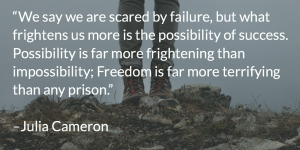Women Leaders – a reflection of impact and what holds us back
Part II of “Infusion of the Feminine Element in the American Workplace” (Part I posted on August 14, 2012)
“If you think you would exercise it ethically, don’t disdain power. You must embrace it as the essential currency for making things happen.”
– Kim Campbell, former prime minister of Canada
Think about it: What would our world really be like if more women were in charge? If we had a female President. If far more of our Fortune 500 companies were led by women (2% currently). If half of the positions in the US Senate and House were held by women (presently 16%). And if more women were partners in law firms or federal judges (now only 15%). What difference would it make?
I think more women in these roles would in fact make things better. I’m not espousing women versus men nor insinuating one gender superior over the other (tempting as it may be). I simply believe that a more even balance of male and female leadership would yield a world with greater cooperation, flexibility, less conflict, increased dialogue, and cultural understanding.
These characteristics and differences contribute in significant, meaningful ways – results that positively impact a business’ bottom line and yield a more diplomatic culture. This isn’t just my opinion, but evidence backed up by countless studies.
According to Catalyst (a research and advisory organization that tracks women in business), “Fortune 500 companies with the highest representation of women on their boards performed better financially – significantly better. Those with the most saw a 53% higher return on equity, a 42% higher return on sales, and a 66% higher return on invested capital. Findings were consistent across invested capital and industries.”
And in the political realm, while the vast majority of current world leaders are male, women have rapidly assumed these roles, now leading some of the largest, most populated, and most economically successful countries in the world. Female leaders work to ensure diplomacy, freedom, justice, equality, and peace. Presently, we live in a time with the highest total number of female leaders serving simultaneously.
These are compelling reasons for balanced leadership in both the business and political jurisdictions. And this peaks my curiosity…what are the key differences with female influence? The following sources offer a few perspectives.
- Esther Wachs, in her book Why the Best Man for the Job is a Woman examined the careers of 14 top female executives to learn what makes them so successful. Her findings reveal that women have a natural willingness to reinvent the rules, ability to sell their visions, the determination to turn challenges into opportunities – all with a focus on “high touch” in a high tech business world.
- Dee Dee Myers, in Why Women Should Rule the World, proposes that it isn’t a debate about nature or nurture – it’s both. “New tools have allowed scientists to find structural, chemical, genetic, hormonal, and functional differences in male and female brains. And those differences affect the way men and women process language, solve problems, and remember emotional events. They shape our responses to everything from stress, to love, to the funny pages.”
- And in Deborah Tannen’s 1991 best-seller, You Don’t Understand! Women and Men in Conversation, she concludes that “boys’ and girls’ early social lives are so different that they grow up ‘in what are essentially different cultures.’ Thus, talk between women and men is in fact cross-cultural communication, fraught with as many potential misunderstandings as communication between individuals from different countries, ethnic backgrounds, languages, or religious groups.”
As a matter of basic world view, Tannen establishes that “men see themselves as engaged in a hierarchical social order in which they are either ‘one up or one down’ in relation to others. Their communication styles and reactions to others’ communications often stress the need to ‘preserve independence and avoid failure.’ Women, on the other hand, tend to see the world as a ‘network of connections,’ and their communications and interpretations of others’ communications seek to ‘preserve intimacy and avoid isolation.’”
Whether male or female, I think most of us realize that dominating leadership style is becoming less and less popular, replaced with a growing presence of leadership that exhibits flexibility, empathy, openness, and valuing differences. The role of women is helping to build understanding around these values that really matter and make a difference.
I’ve been fortunate to grow up surrounded by strong women – my mom, sister, aunts, and countless mentors. As a result, I’ve always thought that women are very capable leaders – not because women are better or the same as men, but because the many ways women and men are different.
So, I wonder, why don’t women take the lead more? What holds us back? I’ve given this a lot of thought lately and drawn conclusions based on my own experiences as well as accounts shared by Myers and other authors writing on female leadership.
- Women are often given the same responsibility without corresponding authority. We have less power – office, rank, money. As in Myers’ case, the President made the job of Press Secretary less important than it had been previously, and, as a result, it made her less effective.
- We don’t negotiate. We’re simply not socialized to do so. According to Linda Babcock and Sara Laschever in Women Don’t Ask: Negotiation and the Gender Divide, “Whether they want higher salaries or more help at home, women often find it hard to ask. Sometimes they don’t know that change is possible – they don’t know that they can ask. Sometimes they fear that asking may damage a relationship. And sometimes they don’t ask because they’ve learned that society can react badly to women asserting their own needs and desires.”
- We have to fight to be a part of the conversation. Being in the room is not the same as being in the conversation. Women are often treated like they’re invisible. For example, I experience the following situation far too often, and I’ve witnessed the same among my female colleagues: I’ll be at a meeting, and I offer up a comment or perspective, and the conversation continues as if I never spoke. Moments later, a man says virtually the same thing, and his point is acknowledged by several in the group. What the hell! I admit that, as women, we often fail to state our thoughts and ideas forcefully enough – I certainly can be guilty of that. But there’s no way that can account for the frequency with which this happens.
- Sometimes, a woman simply being in the role can make it seem less important. “In fact, women devalue whole sectors of the economy just by showing up,” Myers states. “Studies show that both men and women attach less prestige to certain professions if they have more women – or are expected to have more women in the future. Not only can the presence of women devalue certain jobs, but also it’s often not until the job is devalued that women are even hired. It’s a no-win situation.”
- As women, we have to take the world as we find it. We know that the American culture, systems, and structures are a white male establishment. While it is changing and evolving, anyone functioning in the American workplace must work within that dynamic. “When women in positions of authority conform to traditional female stereotypes, they are too often perceived as ‘too soft’ to be effective,” states Myers. “And when they defy those norms, they are considered ‘too tough,’ unnaturally masculine and out of sync”…a bitch, in other words. There are so many ways for women to lose at this game.
- Women lack access to informal networks. In 2005, the research organization, Catalyst, talked to 950 top executives – both men and women. Fifty-five percent of women said they wanted to be CEOs – virtually the same as the number of men. So why don’t more advance? A quarter of the women said they lacked operational experience, but nearly twice as many said that it was because they were shut out of the informal networks – golf, poker, men’s clubs – where information gets exchanged, relationships get established, and careers get launched. Over time, these little differences become a significant cumulative divide.
- People are more judgmental about a female’s performance and less forgiving of her mistakes than they are of her male counterpart’s. People wonder: Can she stand up to her opponent? Can she think on her feet? People simply assume men are tough enough, but women have to prove it. It’s a fine line with great expectations and little margin for error.
Given these thoughts and others, in the end it’s not necessarily the lack of intrinsic aptitude that keeps more women from pursuing careers in fields like physics and engineering; rather, it may be that their different realities compel them to make different choices. It’s time that those realities are recognized as every bit as relevant, important, and valuable as men’s.
While many variables contribute to holding us back or interfering with our path to success, I conclude too that we – as women – have to get out of our own way. Regardless of the environment in which we operate and the tendency sometimes to blame, we are part of our own problem. I believe this most often when we don’t take or claim our power. Or when we fail to be courageous and stand up for our peer female professionals and confront inequities in the moment, head on. And there are those situations where we act too masculine, not allowing for the time and texture of the feminine accent.
Clearly, men and women are different. And because we’re different, women will bring a varied mix of experience, values, and points of view. We will expand the range of what’s acceptable and what’s possible. It’s in our economic, social, and political interest to create a world that’s freer and fairer. Where everyone has their power and is allowed to use it. Where everyone is judged by their performance – and their potential.
Sources:
- Myers, Dee Dee. Why Women Should Rule the World. New York: HarperCollins, 2008.
- Wachs, Esther. Why the Best Man for the Job is a Woman. New York: HarperCollins, 2001.
- Tannen, Deborah. You Don’t Understand! Women and Men in Conversation. New York: Ballantine Books, 1991.
- Babcock, Linda and Laschever, Sara. Women Don’t Ask: Negotiation and the Gender Divide. New York: Bantam Books, 2007.





Recent Comments